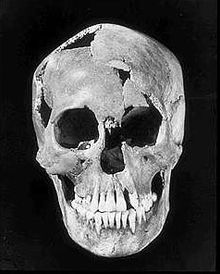| Minnesota Girl | |
|---|---|
 Skull of "Minnesota Woman" Skull of "Minnesota Woman" | |
| Born | c. 5955 B.C |
| Died | c. 5939 B.C (aged c. 16) now Minnesota, United States |
| Body discovered | 16 June 1931 |
| Resting place | South Dakota, United States |

Minnesota Woman, also known as Pelican Rapids-Minnesota Woman (c. 5955 – c. 5939 BC), is the name given to the skeletal remains of a woman thought to be 8,000 years old. The bones were found near Pelican Rapids, Minnesota on June 16, 1931, during construction on U.S. Route 59. The bones were brought to Albert Jenks at the University of Minnesota, who identified them as the bones of a girl who was 15 or 16 years old, but who had never borne children. The girl had two artifacts—a dagger made from an elk's horn and a conch shell pendant. The conch shell came from a whelk species known as Sinistrofulgur perversum, which had previously only been known to exist in Florida.
Discovery
The road crew dug up the site without an investigation by archaeologists, so some of the exact details of the woman's death were hard to determine. The site indicated that the woman had not been ritually buried, and there was a thin layer of broken clam or mussel shells over the body. This led to the hypothesis that the woman had drowned, either by breaking through the ice or by falling off a boat, and that her body had been covered in mud at the bottom of a glacial lake.
Before 1926, most scientists theorized that human beings had only appeared in America within the last couple of thousand years. The discovery of Minnesota Woman provided evidence that humans had been in America for many thousands of years before that. Scientists now recognize the girl as someone whose ancestors were Paleo-American. Radiocarbon dating places the age of the bones approximately 8,000 years ago, approximately 7890 ±70 BP (i.e. between 6009 and 5869 BC); near the beginning of the Archaic period in Minnesota.
These skeletal remains have been reburied in South Dakota on October 2, 1999, by Sioux tribes and are not available for further study.
See also
Notes
- ^ "Academics Archaeology, 1932 to the 1970s." Archived 2013-05-26 at the Wayback Machine University of Minnesota. 21 August 2012. Retrieved 4 September 2012.
- "TimePieces: Trade". Minnesota Historical Society. Archived from the original on 2004-11-06. Retrieved 2007-02-17.
- "Prehistoric Period". Minnesota Office of the State Archaeologist. Archived from the original on 18 October 2017. Retrieved 7 May 2018.
- "Friends of America's Past: Earliest Americans: Status of Ancient Remains". www.friendsofpast.org. Archived from the original on 9 February 2011. Retrieved 7 May 2018.
References
- "The 'Minnesota Woman' - History of Otter Tail County". Archived from the original on 2006-12-07. Retrieved 2006-11-20.
- Albert E. Jenks (1933). "Summary of 'Minnesota Pleistocene Homo . . .'" (PDF). Proceedings of the National Academy of Sciences. 19 (1): 1–6. doi:10.1073/pnas.19.1.1. PMC 1085869. PMID 16587720. Retrieved 2012-03-06.
- Jenks, Albert Ernest (1938). "MINNESOTA MAN: A REPLY TO A REVIEW BY DR ALES HRDLICKA, by Albert E. Jenks, 1938". American Anthropologist. 40 (2): 328–336. doi:10.1525/aa.1938.40.2.02a00290.
- Lass, William E. (1998) . Minnesota: A History (2nd ed.). New York, NY: W.W. Norton & Company. ISBN 978-0-393-04628-1.
46°36′32″N 96°3′10″W / 46.60889°N 96.05278°W / 46.60889; -96.05278
Categories: